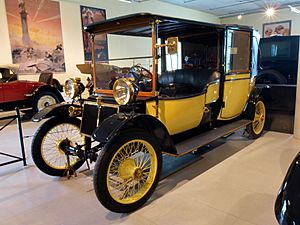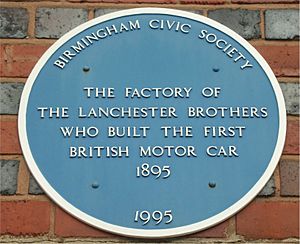Lanchester Motor Company facts for kids
 |
|
| Private | |
| Industry | Automotive |
| Fate | purchased by BSA group 1930 |
| Successor | The Daimler Company Limited |
| Founded | (business) Birmingham 1899 |
| Founder | Frederick Lanchester George Lanchester Frank Lanchester |
| Defunct | dormant since 1955 but currently listed as 'active' |
| Headquarters |
(to 1930) Armourer Mills Birmingham
,
England
|
|
Number of locations
|
(to 1930) Works: Armourer Mills Sparkbrook Birmingham Showrooms: 88 Deansgate Manchester 95 New Bond Street London |
|
Key people
|
(to 1930) Founders Trevor Hamilton Barnsley Whitfield brothers Pugh brothers J S Taylor |
| Products | Motor vehicles |
| Owner | Jaguar Land Rover |
| Parent | The Daimler Company Limited (1930–present) |
 |
|
| Product type | Motor vehicles |
|---|---|
| Owner | Jaguar Land Rover (since 2013) |
| Country | United Kingdom |
| Introduced | 1895 |
| Discontinued | 1955 but company still exists |
| Markets | International |
| Previous owners |
|
The Lanchester Motor Company Limited was a British company that made cars from 1899 to 1955. Even though the company still officially exists, it hasn't made cars since 1955. It's now listed as 'non-trading'.
Until 1931, the Lanchester company was located in Birmingham, England. After that, its cars were made by another company called Daimler in Coventry. In 1930, a larger group called the BSA Group bought Lanchester. Later, in 1960, Lanchester and Daimler became part of Jaguar Cars.
Over the years, the ownership of Lanchester changed hands several times. In 1990, Ford Motor Company bought Jaguar Cars. Then, in 2008, Ford sold both Jaguar and Land Rover to Tata Motors. Tata Motors created a new company called Jaguar Land Rover to own them. In 2013, Jaguar Cars and Land Rover merged to form Jaguar Land Rover Limited. This new company now owns the rights to the Lanchester car brand.
Contents
History of Lanchester Cars
The Lanchester Brothers
The Lanchester car business was started by three brothers: Frederick Lanchester, George Lanchester, and Frank Lanchester. Frederick was a very important car engineer in the late 1800s and early 1900s. In December 1899, they officially formed The Lanchester Engine Company Limited. They had financial help from other people, including the Pugh brothers from Rudge-Whitworth.
Work on the very first Lanchester car began in 1895. It was special because it was designed from scratch as a car, not just a "horseless carriage" (a regular carriage with an engine added). This first car drove on public roads in early 1896. It had a unique engine that ran very smoothly.
In 1897, they put a two-cylinder engine into the same car. They also built a second car. This led to their first cars for sale in 1900, when they made six cars to show people. These cars had two-cylinder engines and used a side lever (or tiller) for steering instead of a steering wheel. The first cars were sold to the public in 1901.
In 1902, Lanchester became the first company to sell cars with disc brakes to the public. These were mechanical brakes on the front wheels. Even though they were simple, they were true disc brakes and came out many years before others.
Early Car Designs
In January 1903, at the Crystal Palace Automobile Show, Lanchester cars were praised for their unique design and smooth ride. People noted that the cars were different from others because of their special engine and gear system.
Until 1903, other companies built the car bodies for Lanchester. But in 1903, Lanchester started its own body-building department. Most cars had Lanchester-built bodies until 1914. In 1904, even though they had many orders, the company ran into financial trouble and had to be reorganized. It was then renamed The Lanchester Motor Company Limited.
The 1904 models had a new four-cylinder engine that was water-cooled. These cars had a unique design where the driver sat far forward, and there was no long hood (bonnet) in front. Six-cylinder models were added in 1906. Over time, Lanchester cars started to look more like other cars. Steering wheels became an option in 1908 and standard by 1911.
Frederick Lanchester left the company in 1913, and his brother George Lanchester took over. Frank Lanchester managed the sales office in London. Just before World War I, they introduced the "Forty" model, which had a more conventional engine position.
- Lanchester Cars Before 1914
World War I Efforts
During World War I, the company helped with the war effort. They made artillery shells and some aircraft engines. They also continued to build vehicles, including Lanchester armoured cars. These armored cars were built on the Lanchester 38 hp car chassis and were used by the Royal Naval Air Service on the Western Front.
After the War
After World War I, Lanchester focused on making just one model, the "Forty." This was a very expensive car, even more costly than a Rolls-Royce Silver Ghost. To keep making cars, they introduced a smaller car, the "Twenty One," in 1924. This car had a six-cylinder engine and four-wheel brakes. It was later updated to the "Twenty Three" model. The "Forty" was eventually replaced by the "Thirty" in 1928. Lanchester also made more armored cars in 1927.
In 1928, George Lanchester designed his last car, a straight-eight engine model. However, only 126 of these were made before the economic depression hit, which greatly reduced the demand for expensive cars.
- Lanchester Cars in the 1920s
The Company is Sold
In late 1930, just after the Wall Street Crash, Lanchester's bank asked for its money back. This forced the company to sell its assets. Since their factory was next to the BSA's factory, it made sense for BSA to buy them. The main owner of Lanchester, Thomas Hamilton Barnsley, sold the company to the BSA group in January 1931. The price was £26,000, which was much less than the company's value. Car production then moved to Daimler's factory in Coventry, as Daimler was also owned by BSA.
Lanchester and Daimler
Even after the sale, George Lanchester stayed on as a senior designer, and Frank Lanchester became the sales director. The first new car they offered was the Lanchester Eighteen, which was a version of the Daimler Light Twenty. It had new features like hydraulic brakes. The "Ten" model in 1933 was a more luxurious version of the BSA Ten.
Even King George VI, when he was the Duke of York, liked Lanchester cars. He owned several in the 1920s and 1930s. He preferred the less flashy look of a Lanchester compared to a Daimler, and even had special Daimler limousines made with the Lanchester grille and badges.
After World War II, Lanchester brought back a ten-horsepower car called the LD10. They also made the "Fourteen / Leda" model. The very last model, called the Sprite, was only made as a prototype and never went into full production.
- Lanchester Cars After the Sale to BSA Group
Lanchester's Journey to Jaguar Land Rover
Daimler's business started to decline. In 1960, BSA sold Daimler's factories and business to Jaguar Cars. Since then, Jaguar has used the Daimler name for its most expensive cars. Jaguar later became part of the Ford group and then, in 2008, was sold to Tata Motors. So, since 2008, Lanchester has been part of Tata Motors, under the Jaguar Land Rover company.
Lanchester Car Models
| Type | Engine | Approx. production | Year | Notes |
|---|---|---|---|---|
| Lanchester Five | 1306 cc single-cylinder air-cooled | 1 | 1895 | Experimental |
| Lanchester Eight | 3459 cc twin-cylinder air-cooled | 3 | 1897–1898 | Experimental |
| Lanchester Ten | 4033 cc twin-cylinder air-cooled | 1900–1904 | First production model | |
| Lanchester Twelve | 4033 cc twin-cylinder water-cooled | 1903–1904 | ||
| Lanchester Sixteen | 4838 cc twin-cylinder air-cooled | 20 | 1903–1904 | |
| Lanchester Eighteen | 4838 cc twin-cylinder water-cooled | 6 | 1904 | |
| Lanchester Twenty | 2472 cc overhead-valve four-cylinder water-cooled | 1904–1911 | ||
| Lanchester Twelve | 3974 cc twin-cylinder overhead-valve water-cooled | 1906–1908 | ||
| Lanchester 28 | 3654 cc six-cylinder overhead-valve water-cooled | 1906–1911 | ||
| Lanchester 50 | 8145 cc six-cylinder overhead-valve water-cooled | 1 car, 2 engines | 1907 | Experimental |
| Lanchester 38 | 4856 cc six-cylinder overhead-valve water-cooled | 1911–1914 | ||
| Lanchester 25 | 3137 cc four-cylinder overhead-valve water-cooled | 1912–1914 | ||
| Lanchester 40 | 5482 cc six-cylinder side-valve water-cooled | 1914 | ||
| Lanchester 40 | 6178 cc six-cylinder overhead-cam water-cooled | 392 | 1919–1928 | Chassis £2200. Four-wheel brakes from 1924 |
| Lanchester 21 | 2930 cc six-cylinder overhead-cam water-cooled | 735 (including Twenty Three) | 1923–1926 | Chassis £1000. |
| Lanchester 23 | 2930 cc six-cylinder overhead-cam water-cooled | 735 (including Twenty One) | 1926–1931 | Vacuum servo. |
| Lanchester petrol-electric | 1927 | Experimental; now in Thinktank, Birmingham Science Museum | ||
| Lanchester 30 hp | 4400 cc eight-cylinder overhead-cam water-cooled | 126 | 1929–1932 | Chassis £1325 |
| January 1931 business purchased by The Birmingham Small Arms Company Limited |
||||
| Lanchester 15/18 and Eighteen | 2504 cc (2390 cc from 1935, 2565 cc from 1936) six-cylinder overhead-valve water-cooled | 2650 approx | 1932–1940 | Badge engineered Daimler Light 20. Fluid flywheel. |
| Lanchester Ten LA10 | 1203 cc (1444 cc from 1936) four-cylinder overhead-valve water-cooled | 12250 approx | 1933–1936 | Fluid flywheel. Hydraulic brakes until 1935. |
| Lanchester Light Six | 1378 cc six-cylinder overhead-valve water-cooled | 1075 approx | 1935–1936 | Saloon, Sports Saloon, Drophead Coupe. Similar to BSA. |
| Lanchester Eleven | 1444 cc four-cylinder overhead-valve water-cooled | 2000 approx | 1937–1940 | Saloon, Sports Saloon. |
| Lanchester Fourteen Roadrider | 1527 cc (1809 cc from 1938) six-cylinder overhead-valve water-cooled | 2000 approx | 1937–1940 | Saloon, Sports saloon. bendix brakes |
| Lanchester Ten LD10 | 1287 cc four-cylinder overhead-valve water-cooled | 3030 | 1946–1951 | Independent front suspension, Mechanical brakes |
| Lanchester Fourteen/Leda | 1968 cc four-cylinder overhead-valve water-cooled | 2100 | 1950–1954 | Appropriated for badge engineered 1953 Daimler Conquest. Saloon and drophead coupe. |
| Lanchester Sprite | 1622 cc four-cylinder overhead-valve water-cooled | 10 | 1954–1956 | Hobbs automatic gearbox. Did not reach production. |
Monuments to Lanchester
In Birmingham, there is an outdoor sculpture called the Lanchester Car Monument. It was designed by Tim Tolkien and is located where Lanchester built their first four-wheel petrol car in 1895. There is also a blue plaque on the former factory building, remembering the Lanchester brothers.
See also
- List of car manufacturers of the United Kingdom


















